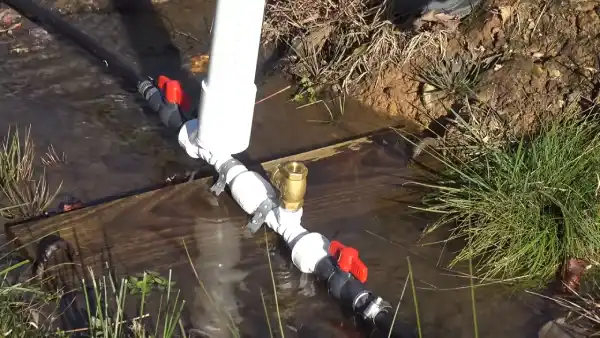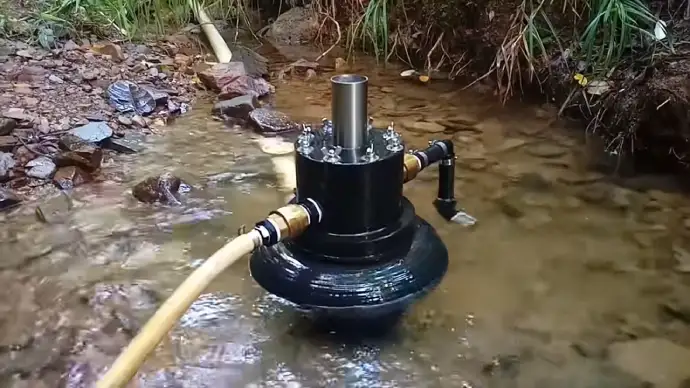Last Updated on May 10, 2023
Gravity pumps are a true marvel of engineering, allowing people to quickly and efficiently move water even in the most challenging conditions. With their simple and reliable design, it’s no surprise that they remain a popular choice for small farms and rural households alike.
Yet, despite their popularity, many of us lack a deep understanding of how these pumps actually work. The secret lies in the pressure intensifier principle, which utilizes a large-diameter piston to act on a volume of low-pressure water.
With its long, heavy lever arm and simple physics, this pump increases pressure to drive water straight to where it’s most needed. Seeing how such a basic technology has stood the test of time and remains a reliable solution even today is amazing.
Keep reading to learn more about how gravity pumps work and how they can help you streamline your water management processes.
How Does a Gravity Pump Work: A Detailed Explanation

A gravity pump is a simple and effective technique for delivering water to remote locations without electricity or other power sources. This pump, also known as a hydraulic ram, works on a simple yet ingenious principle.
Firstly, a column of water is allowed to flow downhill through a pipe. As the water gains speed, it also gains kinetic energy. Then, a valve is closed at the lower end of the pipe to create an abrupt stop for the flowing water.
An increase in pressure below the column, caused by the water’s momentum, triggers a one-way valve at the pipe’s lower end to open, letting some water out. As the water escapes, it rises upward through a second pipe.
The escaping water enters a head tank usually filled with air, and the compressed air is then employed to push water through the pump’s outlet, providing the pumping action. The key factor that governs the pump’s operation is the opening and closing of the valve at the bottom of the first pipe.
The valve must be open long enough for the water in the pipe to reach a suitable speed. To lift the water up to the delivery point, the valve must be abruptly closed.
This technique is known as a hydraulic ram and has proven to be a reliable and effective method of lifting water using the energy of flowing water. This practical invention has been used for centuries to provide remote communities with accessible water sources.
What Are the Advantages Of Using a Gravity Pump?

Gravity pumps provide numerous advantages compared to traditional pumping systems. Discover the key benefits:
#1. Energy Efficient
Generally speaking, gravity pumps are the most energy-efficient gravity fed water systems. As they use natural gravitational pull to pump water, no electricity or fuel is required to operate them. Therefore, they are ideal for remote locations with limited access to electricity.
Gravity pumps can source energy from various water sources such as springs, creeks, or ponds. However, a water source must be above the pump to ensure proper functioning.
#2. Easy to Install
Installing and operating gravity flow pumps requires minimal technical skills. Unlike conventional pumping systems that require electrical wiring and plumbing, gravity pumps require neither, making them ideal for DIY enthusiasts.
Gravity pumps are particularly suitable for areas with limited access to skilled technicians, making them popular in remote rural areas.
#3. Low maintenance
Gravity pumps require minimal maintenance, as they have no moving or electrical parts. The chances of breakdowns and repairs are also reduced with fewer parts to maintain. Therefore, specific gravity pumps work great in remote areas with limited access to repair services.
#4. Reliable
As outlined above, gravity pumps are highly reliable, unaffected by power outages, and require little to no maintenance. Due to their simple and robust design, gravity pumps can provide a long-term solution for water transportation needs.
#5. Environmentally Friendly
Gravity pumps are ideal for reducing carbon footprint, as they have no emissions or waste products. So they are environmentally friendly and sustainable, making them suitable for off-grid living.
Are There Any Limitations to Using a Gravity Pump?

Gravity pumps also have some limitations you need to know to determine if they suit your needs. One of the primary limitations is that gravity pumps require a slope higher than the delivery location. Therefore, the availability of a suitable elevation is a critical requirement.
Also, a continuous water supply must be available to maintain the proper function of the pump, which can limit its practicality in certain situations.
Furthermore, the height differential between the source and delivery points is a crucial factor in determining the maximum output of a gravity pump. As the height differential increases, the available pressure and flow rate will decrease, reducing the system’s efficiency.
Similarly, the length and diameter of the delivery conduit can also significantly impact the flow rate and output of the pump. They must be carefully considered to optimize performance.
Can a Gravity Pump Be Used For All Types Of Water Sources?
A gravity pump is specifically designed for water sources at a higher elevation than the delivery location. This type of pump pulls water from springs, creeks, rivers, rain barrels, and other similar sources upstream or uphill from the desired location.
The efficiency of gravity pumps depends on the elevation difference and water quality between the source and delivery location. Water pressure is higher at higher elevations, so pumping is more efficient.
What Is the Maximum Height That a Gravity Pump Can Lift Water?
Lifting water to great heights has always been a challenge in the world of engineering. Gravity pumps have been a savior in these situations, but the question arises: what height can they lift?
While it might be challenging to provide an exact answer due to multiple factors at play, a high-lift gravity pump has shown to be an effective option, achieving a total lift of over 1000 feet. The pump’s impressive performance can be credited to the significant pressure generated within it, allowing it to overcome any resistance.
Then again, the answer to the ultimate question largely depends on several factors, including the pump’s type and size and the water source and destination’s characteristics. Regardless, the high-lift gravity pump is a reliable and efficient option for transporting water over extensive distances.
Is It Okay to Use a Gravity Pump In a Residential Or Agricultural Setting?

Access to reliable sources of water is essential for both residential and agricultural settings. Gravity pumps are an excellent solution for those seeking to ensure a steady flow of water, regardless of access to electricity or utilities.
Gravity pumps provide 1500 gallons a day and are cost-effective, eco-friendly, and easy to maintain. They are a great option for irrigating crops, watering livestock, or providing water for household use without electricity.
Efficient and Smart Water Source: Gravity Pumps
As we end this discussion, it’s worth considering the significant benefits of gravity pumps. They represent a smart, low-cost solution for those in need of an effective water source wherever electricity or fuel is not readily available.
Gravity pumps use a simple but effective method to pump water without needing external energy sources. They’re commonly used in agriculture and animal husbandry, where a reliable water supply can make all the difference.
Not only are they efficient and practical, but they’re also kinder to the environment than other options. Overall, gravity pumps are an excellent example of how simple, effective solutions can deliver outstanding results for various pump applications.


